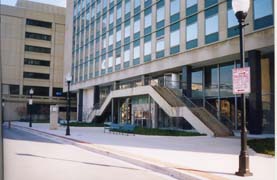Think of a name for an apartment complex where married and single people who are volunteering their services for two years are charged below market rent. I bet “convent” is not the first word that pops in to your mind. That is what Maryland ends up calling the residence associated with the Washington, DC temple of the Church of Latter Day Saints in the decision in the case B. MARIE GREEN, SUPERVISOR OF ASSESSMENTS OF MONTGOMERY COUNTY v. CHURCH OF JESUS CHRIST OF LATTER DAY SAINTS .
Having property be exempt from local real estate taxes is often much more challenging than simply qualifying as a 501(c)(3) organization. Although the Mormons won this case it was not without a struggle. Here is a little bit of the story:
The D.C. Temple opened in Kensington,Maryland in 1974. The Temple is generally open 14 hours a day, five days of the week, serving the roughly 145,000 members who live within the D.C. Temple District. The ordinance workers who serve at the Temple mostly come from outside the D.C. area. In order to accommodate ordinance workers from out-of-town, the Church purchased a 44-unit apartment complex for them to live in, located in Kensington about a mile from the Temple. Between 50 to 60 ordinance workers live in the complex, the majority of whom are retired, married couples. The ordinance workers worship together as a ward each Sunday at a chapel located on the Temple grounds. The Church charges the ordinance workers below-market-value rent as a means of off-setting the operating expenses of the complex.
The relevant portion of the statute exempts from local property tax property that is used as “a parsonage or convent”.
The Maryland Tax Court had ruled against LDS basing its decision on a traditional dictionary definition of convent:
The dictionary definitions of convent and monastery do not include married men and women and single persons living separate lives in separate households. Ordinance workers do not take vows of poverty, chastity and obedience to a superior as do a typical monk or nun. Ordinance workers do not make lifetime commitments like nuns and monks and do not keep a common purse or share things in common. Moreover, as is the case with supplying a house to a minister or supplying a place to live in a convent, nuns and ministers do not pay rent to the Church for a home in which to live.
The Court of Appeals was more inclined to try to discern the legislative intent in the statute:
Distilling the various definitions offered by the parties and researched by this Court, we have concluded that there are several basic qualities a convent must contain in order to be eligible for a tax exemption: A convent consists of a community of people who live together, follow strict religious vows, and devote themselves full-time to religious work. This definition does not expand impermissibly the scope of the property tax exemption, and it avoids an unduly narrow reading of the statute.
The ordinance workers qualify as a “community of people who live together.” Although the workers inhabit separate units within the apartment complex, they live together at one location, socialize, and worship together as a group every Sunday. In addition, the ordinance workers “follow strict religious vows” and are removed from their positions working in the Temple if they forsake them. Finally, the ordinance workers “devote themselves full-time to religious work,” as they spend their days each week during their two-year commitment performing religious ceremonies within the Temple, and they hold no outside employment.
The DC Temple, by the way is noted for its festival of lights. It looks pretty impressive.
You can follow me on twitter @peterreillycpa.
Originally published on Forbes.com Feb 7th, 2013































































































